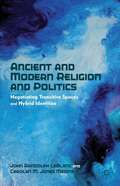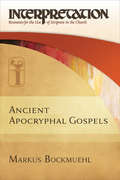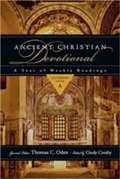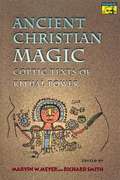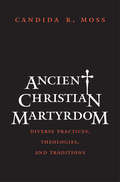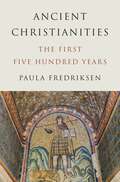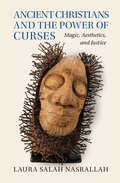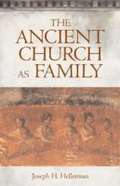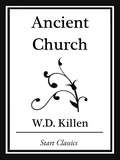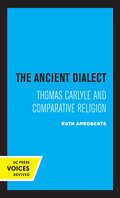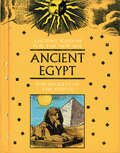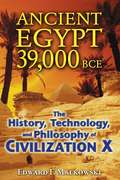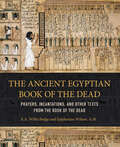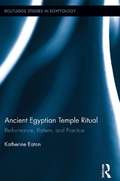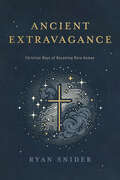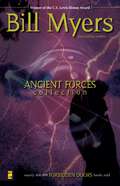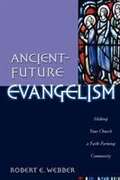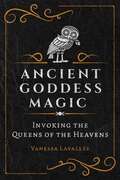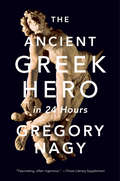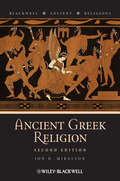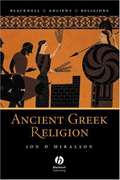- Table View
- List View
Ancient and Modern Religion and Politics
by John Randolph Leblanc Carolyn M. Jones MedineThis book brings a variety of voices into conversation about the issues of identity, community, tension and violence, and peace in the West: from Sophocles to Alice Walker, from Lincoln to Martin Luther King, Jr. and from Euripides to Edward Said.
Ancient Apocryphal Gospels
by Markus BockmuehlIn this reader-friendly guide, Markus Bockmuehl offers a sympathetic account of the ancient apocryphal Gospel writings, showing their place within the reception history and formation of what was to become the canonical fourfold Gospel. Bockmuehl begins by helping readers understand the early history behind these noncanonical Gospels before going on to examine dozens of specific apocryphal texts. He explores the complex oral and intertextual relationships between the noncanonical and canonical Gospels, maintaining that it is legitimate and instructive to read the apocryphal writings as an engagement with the person of Jesus that both presupposes and supplements the canonical narrative outline. Appropriate for pastors and nonspecialists, this work offers a fuller understanding of these writings and their significance for biblical interpretation in the church.
Ancient Christian Devotional: A Year of Weekly Readings
by Thomas C. Oden Cindy CrosbyThis guide to prayer and reflection combines excerpts from the writings of the church fathers as found in the Ancient Christian Commentary on Scripture with a simple structure for daily or weekly reading and prayer. There are fifty-two weeks of readings following the weekly lectionary cycle A. You can read through them in order or by thematic interest. Each day you will also find a simple opening and closing prayer drawn from the prayers and hymns of the ancient church. Come and find the deep nourishment God offers through the insights of this "cloud of witnesses"--the ancient church fathers.
Ancient Christian Ecopoetics: Cosmologies, Saints, Things (Divinations: Rereading Late Ancient Religion)
by Virginia BurrusIn our age of ecological crisis, what insights—if any—can we expect to find by looking to our past? Perhaps, suggests Virginia Burrus, early Christianity might yield usable insights. Turning aside from the familiar specter of Christianity's human-centered theology of dominion, Burrus directs our attention to aspects of ancient Christian thought and practice that remain strange and alien. Drawn to excess and transgression, in search of transformation, early Christians creatively reimagined the universe and the human, cultivating relationships with a wide range of other beings—animal, vegetable, and mineral; angelic and demonic; divine and earthly; large and small.In Ancient Christian Ecopoetics, Burrus facilitates a provocative encounter between early Christian theology and contemporary ecological thought. In the first section, she explores how the mysterious figure of khora, drawn from Plato's Timaeus, haunts Christian and Jewish accounts of a creation envisioned as varyingly monstrous, unstable, and unknowable. In the second section, she explores how hagiographical literature queers notions of nature and places the very category of the human into question, in part by foregrounding the saint's animality, in part by writing the saint into the landscape. The third section considers material objects, as small as portable relics and icons, as large as church and monastery complexes. Ancient Christians considered all of these animate beings, simultaneously powerful and vulnerable, protective and in need of protection, lovable and loving. Viewed through the shifting lenses of an ancient ecopoetics, Burrus demonstrates how humans both loomed large and shrank to invisibility, absorbed in the rapture of a strange and animate ecology.
Ancient Christian Magic: Coptic Texts of Ritual Power
by Marvin Meyer Richard Smith Neal KelseyThe main purpose of this volume is to present in English translation a representative selection of 135 Coptic texts of ritual power.
Ancient Christian Martyrdom
by Candida R MossThe importance of martyrdom for the spread of Christianity in the first centuries of the Common Era is a question of enduring interest. In this innovative new study, Candida Moss offers a radically new history of martyrdom in the first and second centuries that challenges traditional understandings of the spread of Christianity and rethinks the nature of Christian martyrdom itself. Martyrdom, Moss shows, was not a single idea, theology, or practice: there were diverse perspectives and understandings of what it meant to die for Christ. Beginning with an overview of ancient Greek, Roman, and Jewish ideas about death, Moss demonstrates that there were many cultural contexts within which early Christian views of martyrdom were very much at home. She then shows how distinctive and diverging theologies of martyrdom emerged in different ancient congregations. In the process she reexamines the authenticity of early Christian stories about martyrs and calls into question the dominant scholarly narrative about the spread of martyrdom in the ancient world.
Ancient Christianities: The First Five Hundred Years
by Paula FredriksenHow, over the course of five centuries, one particular god and one particular Christianity came to dominate late Roman imperial politics and piety The ancient Mediterranean teemed with gods. For centuries, a practical religious pluralism prevailed. How, then, did one particular god come to dominate the politics and piety of the late Roman Empire? In Ancient Christianities, Paula Fredriksen traces the evolution of early Christianity—or rather, of early Christianities—through five centuries of Empire, mapping its pathways from the hills of Judea to the halls of Rome and Constantinople. It is a story with a sprawling cast of characters: not only theologians, bishops, and emperors, but also gods and demons, angels and magicians, astrologers and ascetics, saints and heretics, aristocratic patrons and millenarian enthusiasts. All played their part in the development of what became and remains an energetically diverse biblical religion.The New Testament, as we know it, represents only a small selection of the many gospels, letters, acts of apostles, and revelations that circulated before the establishment of the imperial church. It tells how the gospel passed from Jesus, to the apostles, thence to Paul. But by using our peripheral vision, by looking to noncanonical and paracanonical texts, by availing ourselves of information derived from papyri, inscriptions, and archaeology, we can see a different, richer, much less linear story emerging. Fredriksen brings together these many sources to reconstruct the lively interactions of pagans, Jews, and Christians, tracing the conversions of Christianity from an energetic form of Jewish messianism to an arm of the late Roman state.
Ancient Christians and the Power of Curses
by Laura Salah NasrallahAncient Christians and their non-Christian contemporaries lived in a world of 'magic.' Sometimes, they used curses as ritual objects to seek justice from gods and other beings; sometimes, they argued against them. Curses, and the writings of those who polemicized against curses, reveal the complexity of ancient Mediterranean religions, in which materiality, poetics, song, incantation, and glossolalia were used as technologies of power. Laura Nasrallah's study reframes the field of religion, the study of the Roman imperial period, and the investigation of the New Testament and ancient Christianity. Her approach eschews disciplinary aesthetics that privilege the literature and archaeological remains of elites, and that defines curses as magical materials, separable from religious ritual. Moreover, Nasrallah's imaginative use of art and 'research creations' of contemporary Black painters, sculptors, and poets offer insights for understanding how ancient ritual materials embedded into art work intervene into the present moment and critique injustice.
The Ancient Church As Family: Early Christian Communities And Surrogate Kinship
by Joseph H. HellermanThe author explores the literature of the first three centuries of the church in terms of group identity and formation as surrogate kinship. Why did this become the organizing model in the earliest churches? How did historical developments intervene to shift the paradigm? How do ancient Mediterranean kinship structures correlate with church formation? Hellerman traces the fascinating story of these developments over three centuries and what brought them about. His focus is the New Testament documents (especially Paul's letters), second-century authors, and concluding with Cyprian in the third century. Kinship terminology in these writings, behaviors of group solidarity, and the symbolic power of kinship language in these groups are examined.
Ancient Church (Start Classics)
by W. D. KillenThe appearance of another history of the early Church requires some explanation. As the progress of the Christian commonwealth for the first three hundred years has been recently described by British, German, and American writers of eminent ability, it may, perhaps, be thought that the subject is now exhausted. No competent judge will pronounce such an opinion. During the last quarter of a century, various questions relating to the ancient Church, which are almost, if not altogether, ignored in existing histories, have been earnestly discussed; whilst several documents, lately discovered, have thrown fresh light on its transactions. There are, besides, points of view, disclosing unexplored fields for thought, from which the ecclesiastical landscape has never yet been contemplated. The following work is an attempt to exhibit some of its features as seen from a new position.
An Ancient Commentary on the Book of Revelation
by P. TzamalikosThis is a new critical edition, with translation and commentary, of the Scholia in Apocalypsin, which were falsely attributed to Origen a century ago. They include extensive sections from Didymus the Blind's lost Commentary on the Apocalypse (fourth century) and therefore counter the current belief that Oecumenius' commentary (sixth century) was the most ancient. Professor Tzamalikos argues that their author was in fact Cassian the Sabaite, an erudite monk and abbot at the monastery of Sabas, the Great Laura, in Palestine. He was different from the alleged Latin author John Cassian, placed a century or so before the real Cassian. The Scholia attest to the tension between the imperial Christian orthodoxy of the sixth century and certain monastic circles, who drew freely on Hellenic ideas and on alleged 'heretics'. They show that, during that period, Hellenism was a vigorous force inspiring not only pagan intellectuals, but also influential Christian quarters.
The Ancient Dialect: Thomas Carlyle and Comparative Religion
by Ruth apRobertsThis title is part of UC Press's Voices Revived program, which commemorates University of California Press’s mission to seek out and cultivate the brightest minds and give them voice, reach, and impact. Drawing on a backlist dating to 1893, Voices Revived makes high-quality, peer-reviewed scholarship accessible once again using print-on-demand technology. This title was originally published in 1988.
Ancient Egypt: The Secrets of the Sphinx (Ancient Wisdom for the New Age)
by Zelda SharifDiscover how the wisdom of ancient Egypt can provide guidance for living in the modern world with this fascinating, fully illustrated guide. Today, there are countless New Age philosophies designed for self-improvement and spiritual development, but none of them match the timeless wisdom contained within the mysteries of Ancient Egypt. This volume introduces readers to the ways of the pharaohs; their relationship to the land and the river Nile; their positive attitudes toward death and the afterlife as set down in The Book of the Dead; and their sacred rites, symbols, and stones which have had a profound influence on cultures throughout history. Fully illustrated with magnificent artwork, this volume also covers Ancient Egyptian history, archeological sites, mysterious relics, and speculation about the meaning and power of the pyramids.
Ancient Egypt 39,000 BCE: The History, Technology, and Philosophy of Civilization X
by Edward F. MalkowskiA view into the sophisticated and highly advanced civilization that preceded the world of the pharaohs • Presents historical evidence of the civilization ruled by the “gods” that the Egyptians claimed preceded their own • Explains who these prehistoric people were, what happened to them, and why they built a series of pyramids along the west bank of the Nile River Traditional Egyptologists have long resisted the notion that the architectural achievements of the Ancient Egyptians required the existence of a much more sophisticated technology than would have existed at that time. Yet, no records exist explaining how, why, or who built Egypt’s megalithic monuments and statues. The ancient Egyptians did, however, record that their civilization resided in the shadow of a kingdom of “gods” whose reign ended many thousands of years before their first dynasty. What was this Civilization X that antiquity’s most accomplished people revered as gods? The recent discovery of a large stone at one of Egypt’s oldest ruins presents physical evidence that clearly and distinctly shows the markings of a machining process far beyond the capabilities of the Ancient Egyptians. Likewise, experimental modeling of the Great Pyramid’s subterranean chambers and passageways gives scientific evidence to further support the theory that the civilization responsible for such magnificent monuments is much older than presently believed. Ancient Egypt 39,000 BCE examines this evidence from historical and technical points of view, explaining who these prehistoric people were, what happened to them, why they built their civilization out of granite, and why they built a series of pyramids along the west bank of the Nile River.
The Ancient Egyptian Book of the Dead: Prayers, Incantations, and Other Texts from the Book of the Dead
by E. A. Budge Epiphanius WilsonEasy-to-understand sections help you discover the magic of ancient Egypt in this comprehensive translation of the real Egyptian Book of the Dead.The Ancient Egyptian Book of the Dead is a compendium of classic texts by one of the greatest translators and historians of ancient Egypt, as well as one of the most renowned Egyptologists of all time, E. A. Wallis Budge.In Part I, using plain, simple, easy-to-understand language, Budge delves into the history, instructions, motifs, themes, spells, incantations, and charms written for the dead that ancient Egyptians would need to employ to pass from this world into the next. Throughout centuries, these “books of the dead man” were often found buried alongside mummies and inside tombs, which locals and grave robbers would collect.In Part II, Budge’s classic translation of the Book of the Dead from the Papyrus of Ani (and others) is presented in its original format and contains the prayers, incantations, and ancient text used to help guide the dead during their journey.Finally, in Part III, a list of Egyptian deities is provided. Illustrated throughout with great care, including photos, fine art, and other illustrations, this edition will bring the historic afterlife guide back to life.
Ancient Egyptian Temple Ritual: Performance, Patterns, and Practice (Routledge Studies in Egyptology #1)
by Katherine EatonLarge state temples in ancient Egypt were vast agricultural estates, with interests in mining, trading, and other economic activities. The temple itself served as the mansion or palace of the deity to whom the estate belonged, and much of the ritual in temples was devoted to offering a representative sample of goods to the gods. After ritual performances, produce was paid as wages to priests and temple staff and presented as offerings to private mortuary establishments. This redistribution became a daily ritual in which many basic necessities of life for elite Egyptians were produced. This book evaluates the influence of common temple rituals not only on the day to day lives of ancient Egyptians, but also on their special events, economics, and politics. Author Katherine Eaton argues that a study of these daily rites ought to be the first step in analyzing the structure of more complex societal processes.
Ancient Extravagance: Christian Ways of Becoming More Human
by Ryan SniderFind the beautiful and come alive. We are all frittering away our lives—at least according to someone. They tell us to be productive and not waste our opportunities. In Ancient Extravagance, Ryan Snider shows us that life is more than our accomplishments and what we do. The key to a life of meaning is developing our spiritual senses, which only come awake when we worship with others. That might seem like a waste of time, but in fact, these ancient practices have the power to wake up all parts of our lives—not just Sunday morning. Snider begins with a recovery of childlike wonder and story, reclaiming how prose, poetry, memory, and reflection heal and strengthen the soul. Next, he turns to melodies our grandmothers taught us, examining how they reach into our bones. He then reflects on what it means to eat meals with strangers and how a simple act of hospitality can gently inscribe love, generosity, gratitude, and hospitality in our hearts. These seemingly insignificant practices are mustard seeds that grow into trees to create shade for the world. When we cease simply going to worship and start becoming the worship, we will discover the friendships, beauty, purpose, stories, and sacred moments that will save us and make us more human. Deeply meaningful and delightfully humorous, candid yet surprising, Ancient Extravagance will connect you with a more beautiful and meaningful life.
Ancient Forces Collection (Forbidden Doors)
by Bill MyersIn Volume 4 of the bestselling Forbidden Doors supernatural fiction series, author Bill Myers presents books 10-12-The Ancients, The Wiccan, and The Cards-stories to unmask dangerous occultic influences in young adult lives. With insight and his unsurpassed ability to weave a suspensful story, each volume explores spiritual warfare by presenting biblical truths through realistic situations.
Ancient Forgiveness
by Charles L. Griswold David KonstanIn this book, eminent scholars of classical antiquity and ancient and medieval Judaism and Christianity explore the nature and place of forgiveness in the pre-modern Western world. They discuss whether the concept of forgiveness, as it is often understood today, was absent, or at all events more restricted in scope than has been commonly supposed, and what related ideas (such as clemency or reconciliation) may have taken the place of forgiveness. An introductory chapter reviews the conceptual territory of forgiveness and illuminates the potential breadth of the idea, enumerating the important questions a theory of the subject should explore. The following chapters examine forgiveness in the contexts of classical Greece and Rome; the Hebrew Bible, the Talmud, and Moses Maimonides; and the New Testament, the Church Fathers, and Thomas Aquinas.
Ancient-Future Evangelism: Making Your Church a Faith-forming Community (Ancient-Future Faith Series)
by Robert E. WebberFollowing his well-received Ancient-Future Faith, Robert Webber presents a new model for evangelism and discipleship, the first in a series of four books applying his theoretical ideas to practical situations. <p><p>Part 1 of Ancient-Future Evangelism surveys evangelism and Christian formation throughout the church and then translates the process for twenty-first-century Christians. Webber presents evangelism as four distinct stages and suggests three accompanying rites of passage that can be easily adapted to any church tradition. <p><p>Part 2 underscores how the four-fold process of faith formation is interwoven with three theological principles: Christ as victor over evil, the church as witness to God's salvation, and worship as a witness to God's mission accomplished in Jesus. <p><p>Ancient-Future Evangelism will appeal to both emerging evangelicals as well as traditional church leaders. It relates faith to Christian practice by drawing wisdom from the past and translating those insights into the present and future life of the church.
Ancient Goddess Magic: Invoking the Queens of the Heavens
by Vanessa Lavallée• Explores beliefs and myths from Mesopotamia, ancient Egypt, and around the Mediterranean, revealing how ancient goddesses were powerful Queens of the Heavens and Guardians of the Underworld, not passive fertility symbols• Looks at creator goddesses, sun goddesses, lunar goddesses, warrior maiden goddesses, and night goddesses, including Hathor, Asherah, Inanna, Hekate, Athena, Astarte, and Gula-Bau• Includes modern adaptations of ancient goddess magic rituals and instructions for creating divine amulets, figurines, and stones blessed with the goddesses&’ powersIn the most ancient cultures of our world, goddesses were seen not as passive fertility symbols but as powerful, active queens of the heavens who protected cities, guided the dead and dying, and oversaw all forms of rebirth and transformation. Sharing her years of research and personal exploration, Vanessa Lavallée presents the animistic beliefs of our long-forgotten ancestors and shows how the queens of the heavens still have a vital role to play in modern spirituality.Lavallée looks at sun goddesses who were often viewed as the mothers of the gods and reveals how to spiritually and magically work with creatrix energies. Examining how to work with the warrior goddess archetype found in goddesses such as Athena, Circe the sorceress, and Aphaia from the island of Aegina, the author explains their important connections to the Eagle constellation and eagle lore. Looking at night goddesses, including Gula-Bau, Ataegina, and Hecate, Lavallée explores their star magic and healing powers and describes their connection to death and the underworld as well as to Sirius, the Milky Way, and Vega, the goat star. Exploring lunar goddesses and their role as protectors and their connections to the swan and the Cygnus constellation, she looks at how to work with ladies of the sea such as Astarte, Aphrodite, and Tanit.Offering modern adaptations of ancient goddess magic rituals, Lavallée explains how to perform rituals for healing, protection, and purification and how to create divine amulets and figurines blessed with the goddesses&’ powers. She also reveals how to practice astral bathing for spiritual guidance and presents initiation practices throughout to help you connect with each queen of the heavens.
Ancient Greece, Modern Psyche: Archetypes Evolving
by Virginia Beane Rutter Thomas SingerBetween ancient Greece and modern psyche lies a divide of not only three thousand years, but two cultures that are worlds apart in art, technology, economics and the accelerating flood of historical events. This unique collection of essays from an international selection of contributors offers compelling evidence for the natural connection and relevance of ancient myth to contemporary psyche, and emerges from the second 'Ancient Greece, Modern Psyche' conference held in Santorini, Greece, in 2012.This volume is a powerful homecoming for those seeking a living connection between the psyche of the ancients and our modern psyche. This book looks at eternal themes such as love, beauty, death, suicide, dreams, ancient Greek myths, the Homeric heroes and the stories of Demeter, Persephone, Apollo and Hermes as they connect with themes of the modern psyche. The contributors propose that that the link between them lies in the underlying archetypal patterns of human behaviour, emotion, image, thought, and memory.Ancient Greece, Modern Psyche: Archetypes Evolving makes clear that an essential part of deciphering our dilemmas resides in a familiarity with Western civilization's oldest stories about our origins, our suffering, and the meaning or meaninglessness in life. It will be of great interest to Jungian psychotherapists, academics and students as well as scholars of classics and mythology.
The Ancient Greek Hero in 24 Hours
by Gregory NagyThe ancient Greeks’ concept of “the hero” was very different from what we understand by the term today. In 24 installments, based on the Harvard course Nagy has taught and refined since the 1970s, The Ancient Greek Hero in 24 Hours explores civilization’s roots in Classical literature—a lineage that continues to challenge and inspire us.
Ancient Greek Religion (Blackwell Ancient Religions #15)
by Jon D. MikalsonAncient Greek Religion provides an introduction to the fundamental beliefs, practices, and major deities of Greek religion. Focuses on Athens in the classical period Includes detailed discussion of Greek gods and heroes, myth and cult, and vivid descriptions of Greek religion as it was practiced Ancient texts are presented in boxes to promote thought and discussion, and abundant illustrations help readers visualize the rich and varied religious life of ancient Greece Revised edition includes additional boxed texts and bibliography, an 8-page color plate section, a new discussion of the nature of Greek “piety,” and a new chapter on Greek Religion and Greek Culture
Ancient Greek Religion (Blackwell Ancient Religions Series)
by Jon D. MikalsonAncient Greek Religion provides an introduction to the fundamental beliefs, practices, and major deities of Greek religion. <P><P> Focuses on Athens in the classical period <P><P>Includes detailed discussion of Greek gods and heroes, myth and cult, and vivid descriptions of Greek religion as it was practiced <P><P>Ancient texts are presented in boxes to promote thought and discussion, and abundant illustrations help readers visualize the rich and varied religious life of ancient Greece <P><P>Revised edition includes additional boxed texts and bibliography, an 8-page color plate section, a new discussion of the nature of Greek “piety,” and a new chapter on Greek Religion and Greek Culture
